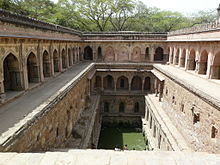Baolis of Mehrauli, Delhi

Gandhak Ki Baoli, one of the three baolis in Mehrauli
The Baolis of Mehrauli are three water wells approached through single stage or three stage steps known as stepwells located inMehrauli in Delhi, India, in the Mehrauli Archaeological Park mainlined by theArchaeological Survey of India. These are the Anangtal Baoli, the Gandhak Ki Baoli, and theRajo ki Baoli.[1][2] These were built below the ground level as ground water edifices and in the context of Hinduism they were built as shrines in medieval times.[3]
Location
The three baolis in Mehrauli are located in theSouth West district of Delhi. They lie in the Archaeological Park maintained by the Archaeological Survey of India near Qutab Minar. Gandhak ki Baoli (to the south of theAdham Khan's tomb[3]) is at one extremity of the Archaeological Park.[1] Rajon ki Baoli is 200 metres (660 ft) away from this baoli.[4]
History
The oldest of the three baolis, Anangtal Baoli, was built in the 11th century (1060 AD[3]) byRajput king Anangpal II of the Tomar dynastyin the then capital area of Lalkhot of Delhi. Gandhak ki Baoli is believed to have been built during the 13th century when the slave dynasty of the Delhi Sultanate Iltutmish(1211–1236 AD) ruled over Delhi. The Rajon ki Baoli is named after the rajmistries or masons who used it. It was built during the 16th century,[3][2][5] by Daulat Khan during the rule of Sikander Lodhi of the Lodhi Dynasty.[2]
Features
Anangtal Baoli
The Anangtal Baoli (28°31′30″N 77°10′58″E), the oldest baoli in Delhi, is a single stage step well.[5]. Excavations at this site reveal that the well was probably very large; some steps leading to the water are extant. It used the technique of rainwater harvesting for its storage
Gandhak ki Baoli
The Gandhak ki Baoli (28°31′15″N 77°10′54″E) is a much larger step well than the Anangtal Baoli. It has decorative architectural features. As the name Gandhak implies, the water in the step well has sulphur content and hence smells of sulphur fumes, and the water is said to have curative quality. It has a simple plan with five stages or floors at each stage, in taper down fashion, with steps leading to the water surface at the lowest level.[1][2] The stairway here is about 40 metres (130 ft) long and 12 metres (39 ft) wide.[3] On each floor there are ornate pillared passages. Over the centuries the step well got silted up and recently ASI imitated action to do desilting.[1][2] the desilting operations carried out by ASI in 2004–05 has resulted in recuperation of the water in the well to a depth of 40 feet (12 m).[4]
Rajon ki Baoli
The Rajon ki Baoli (28°31′13″N 77°11′00″E), rectangular in plan, is the largest and most ornamented of all the three baolis in Mehrauli. It has a series of steps forming four stages, each in descending size, with floors at each stage, leading to the water level from the surrounding ground level. Its appearance is like a courtyard of the medieval period with passages marked by stylized carved symmetrical arches spanning the columns in North Indian architectural style, which form the three sides of the baoli. There are rooms at each floor which once provided a cool resting place for people. With its incised plaster work, the baoli is an elegant architectural edifice. When built the water used to reach up to the third stage.[1][2]Over the centuries the well got silted up. It has since been desilted. The Archaeological Survey of India has carried out desilting operations of the well which was silted to a depth of 20 feet (6.1 m), during 2004–05. As a result, the water level has risen by 20 ft and 60 steps in the well lead to the surface of water.[4]

No comments:
Post a Comment